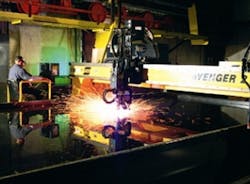Machine Safety: Are You Prepared for the New Standard?
Aug. 24, 2011
3 min read
Outside the issue of machine defects that could render a piece of equipment unsafe to operate, the ultimate responsibility for machine safety has historically rested with the end user. That responsibility is now shifting to machinery OEMs and goes into effect on January 1, 2012, when machine builders and integrators must use EN ISO 13849-1:2008 to prove presumption of conformity with the Machinery Directive. On that date, previously used machine safety standards EN 954-1:1996 and EN ISO 13849-1:1999 may no longer be used for this purpose.
“ISO 13849-1 is the most important standard for regulating the basic principles and performance required of a safety control system for machines and devices. The 2006 revision (approved in 2008, thus the 2008 designation) to this standard is causing major changes to the fundamentals of safety system design, and machine builders and integrators will need to be using this standard as the baseline to prove conformity with the machinery directive by January 1, 2012,” says Frank Webster, vice president, standards development, Omron STI. Webster is a member of Working Groups for Machine Safety in IEC/TC44 and ISO/TC199 and is the convener of IEC/TC44/WG10 developing a new set of standards for vision-based protective devices.
What’s Really Changing for OEMs?
When it comes to OEM implementation of safety protection and measures to reduce machine risks, it has been common practice to evaluate levels of risk reduction and the performance of a safety-related parts of control system in terms of categories as specified in the international standard ISO 13849-1:1999 (based on the European standard EN 954-1).
The latest version of ISO 13849-1:2008 combines the deterministic features of EN 954-1’s Categories with IEC 62061’s probabilistic and systematic design consideration. This means that the revised version of ISO 13849-1 selects the architecture models in IEC 62061 that match the definitions of the categories, and applies reliability models. This version can be called a functional safety standard in its simplified version.
The latest version of ISO 13849-1:2008 combines the deterministic features of EN 954-1’s Categories with IEC 62061’s probabilistic and systematic design consideration. This means that the revised version of ISO 13849-1 selects the architecture models in IEC 62061 that match the definitions of the categories, and applies reliability models. This version can be called a functional safety standard in its simplified version.
Under the new standard, when a machine experiences a failure that causes the expected safety function to fail, if the failure is not detected, it will now be considered equal to non-performance of safety functions.
“For the remainder of 2011, machine builders and integrators can use either EN 954-1:1996, EN ISO 13849-1:1999, or EN ISO 13849-1:2008 to prove presumption of conformity with the Machinery Directive. However, after December 31, 2011, only EN ISO 13849-1:2008 may be used for this purpose,” says Chris Soranno, safety compliance manager, Omron STI.
About the Author
David Greenfield, editor in chief
Editor in Chief
David Greenfield joined Automation World in June 2011. Bringing a wealth of industry knowledge and media experience to his position, David’s contributions can be found in AW’s print and online editions and custom projects. Earlier in his career, David was Editorial Director of Design News at UBM Electronics, and prior to joining UBM, he was Editorial Director of Control Engineering at Reed Business Information, where he also worked on Manufacturing Business Technology as Publisher.
Sign up for our eNewsletters
Get the latest news and updates

Leaders relevant to this article:
